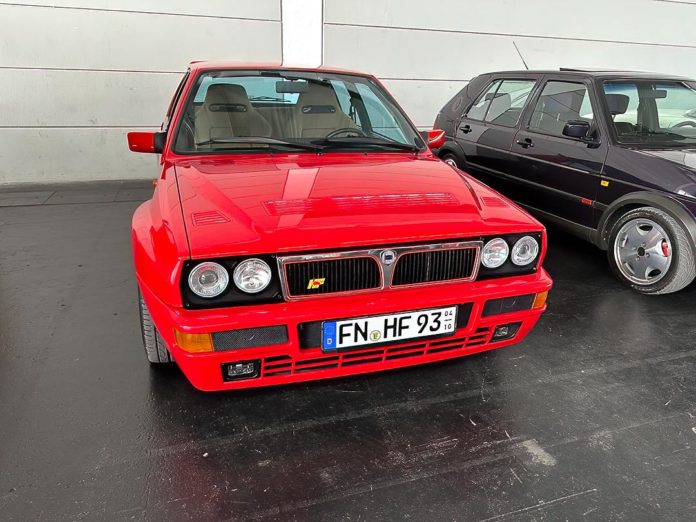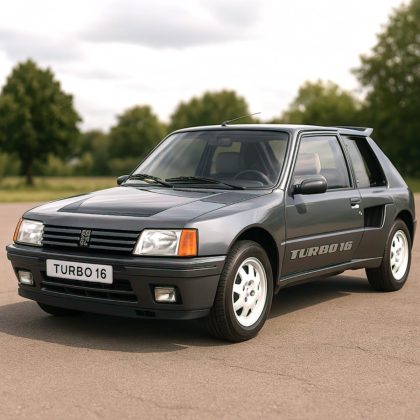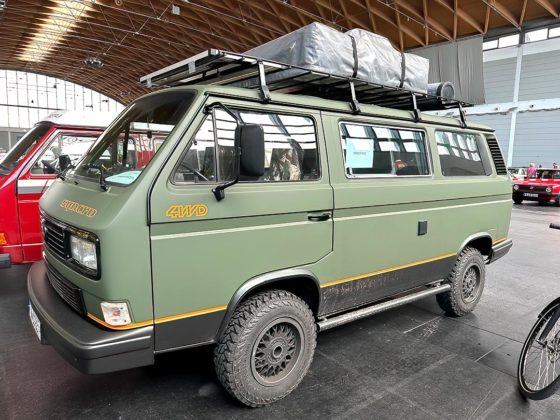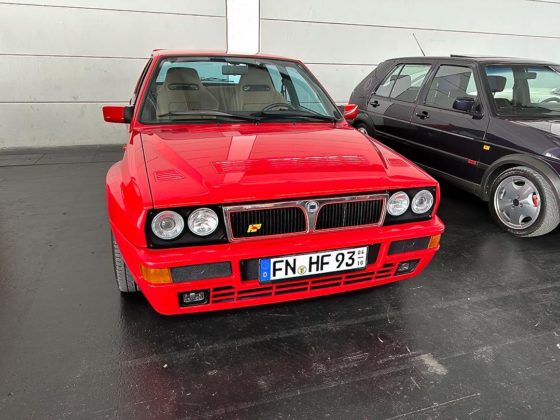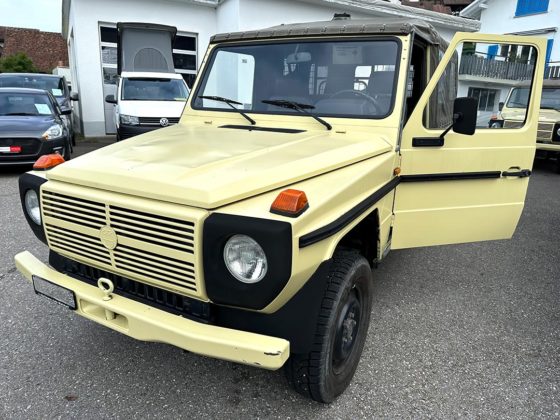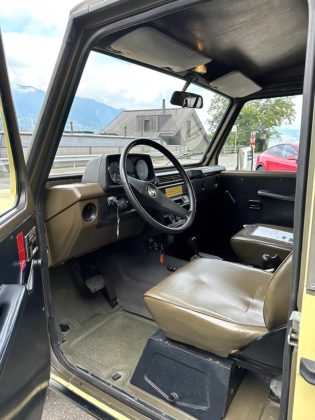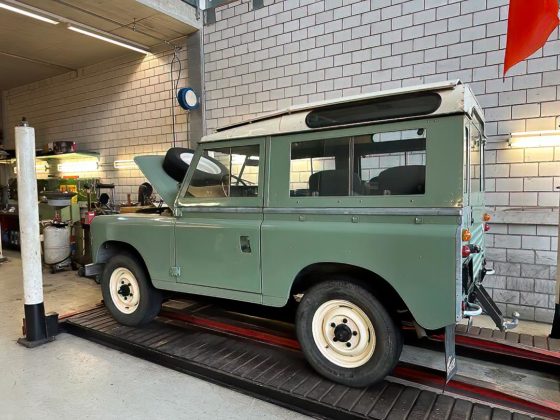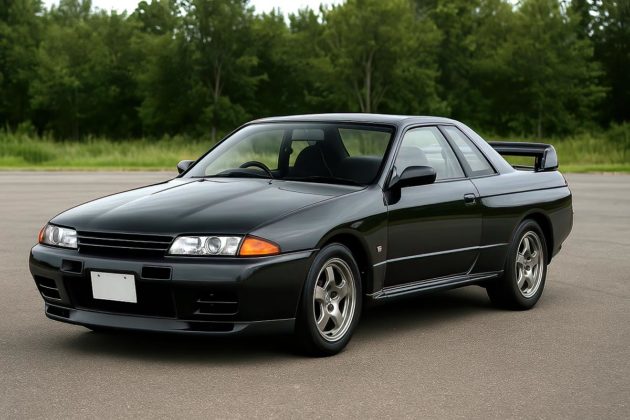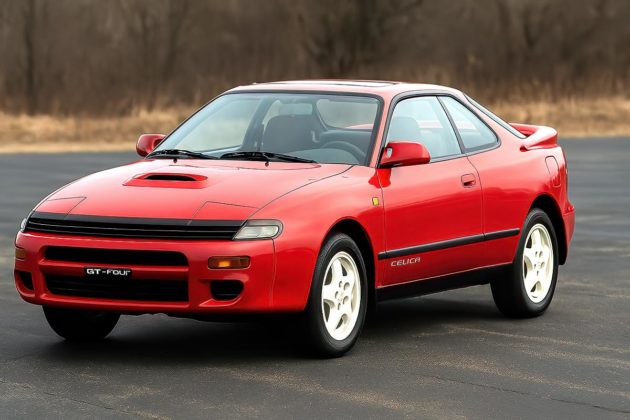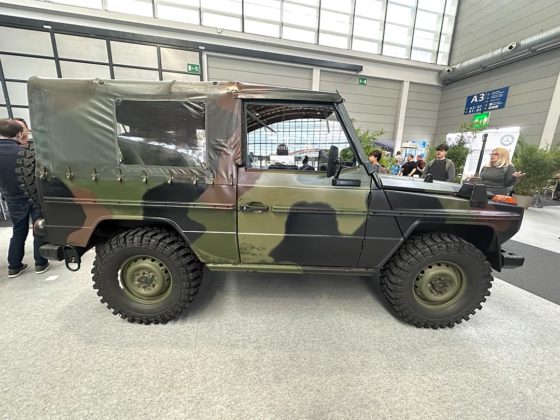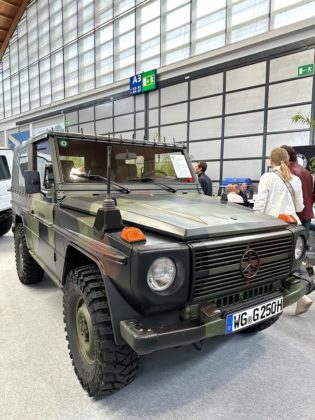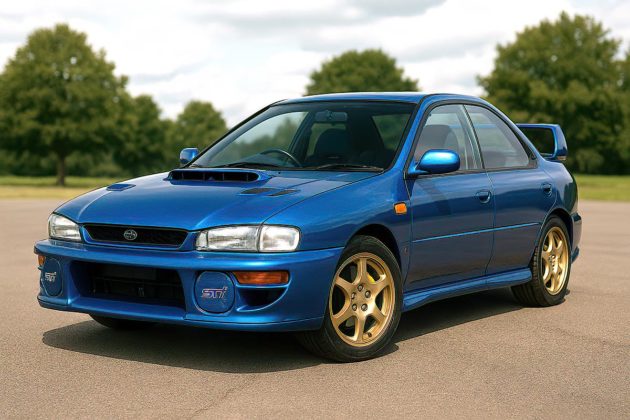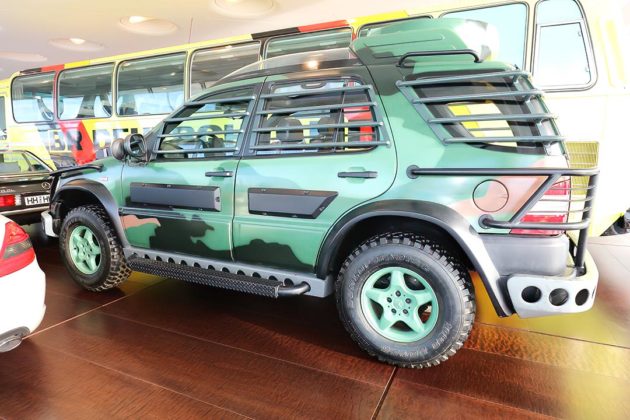When it comes to vintage AWD rally cars, a handful of legends stand out as game-changers. These icons from the 1980s and 1990s not only dominated rally stages but also spawned road-going collectible AWD cars infused with racing technology. We expand our roundup of all-wheel-drive (AWD) heroes with rich details and fact sheets for each model, from Group B monsters to Group A champions. We focus on the road-going version and its standout specs, while highlighting the rally pedigree that cemented its legend.
Audi quattro (Ur-quattro & Sport quattro)
A red Audi Sport Quattro in rally trim on display – the short-wheelbase homologation version that took Audi’s AWD to the world stage.
The Audi quattro revolutionized rallying by introducing four-wheel drive to the World Rally Championship (WRC) in 1981. Its turbocharged five-cylinder “Ur-quattro” coupe brought Group B rally technology to the street, forever earning its place among Group B icons. With its distinctive warbling engine note and sure-footed traction, the quattro coupe proved that sending power to all four wheels was a recipe for domination on loose and slippery surfaces. In competition, it racked up 23 WRC rally wins over six seasons and secured two drivers’ world crowns and two manufacturers’ titles for Audi. The road-going quattro remained in production for over a decade, gaining incremental improvements, most notably the 1984 Sport quattro short-wheelbase homologation special with more power and even sharper handling. Today, any quattro badged in the 1980s – especially an original or Sport quattro – is a sought-after collectible that represents the genesis of the AWD rally revolution.
Audi quattro Fact Sheet:
- Engine & Configuration: 2.1 L inline-5 turbo (10-valve SOHC, later 20V DOHC) mounted up front. Famous for its distinctive five-cylinder thrum.
- Power (Road Car): ~200 PS (147 kW) in the original 1980 model; uprated to 306 PS (302 hp) in the Sport quattro 20V homologation model. Rally versions in Group B tune produced 450+ hp in final S1 E2 form.
- Production Years: 1980–1991 (Ur-quattro road cars; ~11,452 units built). Sport quattro built 1984–1985 (only 214 produced, making it ultra-rare).
- Notable Designers/Engineers: Chassis engineer Jörg Bensinger conceived the quattro idea after winter tests; project leadership under Ferdinand Piëch. The rally team was led by Roland Gumpert. Exterior styling by Martin Smith and team, preserving the Audi Coupe look with box flares.
- AWD System: Permanent all-wheel drive with center differential (manually lockable in early models). The quattro introduced Audi’s now-famous quattro system, using a front-mounted engine and center diff to split torque, giving unprecedented grip on all surfaces.
- Chassis Features: MacPherson strut suspension, wide wheel arches to accommodate larger wheels/tires, and for the Sport quattro, a shortened wheelbase for agility. Massive ventilated disc brakes on Sport quattro.
- Rally Class & Version: Group 4 (1981), then Group B from 1982–1986. Early rally quattros (A1/A2) were based on the long wheelbase; the 1984 Sport quattro S1 featured a shorter body, and the ultimate 1985 S1 E2 had extreme wings and aerodynamic aids. Team: Audi Sport with drivers like Hannu Mikkola, Stig Blomqvist, Michèle Mouton, Walter Röhrl.
- WRC Achievements: Manufacturers’ Champion in 1982 and 1984; Drivers’ World Champion in 1983 (Mikkola) and 1984 (Blomqvist). A total of 23 WRC rally victories from 1981–1986, including Audi’s landmark first win at the 1981 Jänner Rally and dominant performances on snow (Sweden) and gravel (Sanremo, Acropolis). The quattro’s debut changed WRC overnight – by 1984, every top team pursued AWD.
- Notable Special Editions: Street variants include the quattro 20V (1990–91) with a 220 hp 20-valve engine. The Sport quattro itself was a special edition – offered in red, white or green – now worth over $500k at auction due to its low production. Some Sport quattros carried the famed Audi “Mars Red” paint and unique digital dash.
Peugeot 205 Turbo 16
The Peugeot 205 T16 (“Turbo 16”) is a mid-engined pocket rocket that became a Group B rally legend. What looked like a humble 205 hatchback on steroids was actually a purpose-built AWD supercar in disguise – engine behind the front seats, wide aero bodywork, and rally-proven hardware. The street T16 was essentially a detuned rally car sold to meet homologation rules (just 200 made). It packed a turbo four-cylinder punch and all-wheel traction that allowed Peugeot to terrorize the WRC in the mid-1980s. In the hands of drivers like Ari Vatanen, Timo Salonen, and Juha Kankkunen, the 205 T16 took back-to-back world titles and became an icon of the era. The road version, while tamed to around 200 hp, still offered blistering performance for its size and remains one of the most collectible AWD rally cars for enthusiasts. The 205 T16’s rally success rate – winning nearly half of all WRC events it entered – underscores its legendary status.
Peugeot 205 T16 Fact Sheet:
- Engine & Layout: 1.8 L turbocharged inline-4, mid-mounted (right behind the front seats, transverse orientation). Dual overhead cams and 16 valves (hence “T16”).
- Power (Road Car): ~200 PS (147 kW) in street trim. In rally trim, the same engine could output 350–450 hp (and even up to 550 hp in ultimate Evolution spec), making the tiny 205 a rocket.
- Production Years: 1984–1985 (homologation run of 200 units for Group B). Each had special plaque numbers; very few survive in original condition.
- Chief Designer/Engineer: Engineering by Peugeot Talbot Sport under Jean Todt’s leadership. Design-wise, the exterior kept resemblance to the Gérard Welter-designed 205, but with a body by Heuliez for the T16 (wide fenders, scoops). The drivetrain and chassis were engineered by André de Cortanze and his team specifically for rallying.
- Road Car Special Features: Permanent AWD with a center differential (viscous coupling) splitting power to front and rear. Stiff tubular steel chassis with composite body panels. The cabin had a spartan two-seat layout, and even the spare tire was mounted where the rear seats would be. It was essentially a street-legal rally car, complete with an intercooler behind the roof scoop and double-wishbone suspension all around.
- Rally Class & Team: Group B (entered late 1984 through 1986) with Peugeot Talbot Sport. The 205 T16 E1 debuted in ’84, and the Evolution 2 spec in ’85 had more power and aero. Drivers included Vatanen, Salonen, Kankkunen.
- WRC Achievements: Manufacturer’s World Champion in 1985 and 1986; Drivers’ Champion in 1985 (Salonen) and 1986 (Kankkunen). The 205 T16 won 16 World Rally Championship events in its short career, boasting an incredible win rate (~50% of rallies entered). Notable victories: 1985 1000 Lakes and RAC Rally, 1986 Monte Carlo and Swedish Rally. Its dominance helped cement Group B’s reputation for wild performance.
- Special Editions: No multiple trims for the road car – all were similarly equipped 205 T16s in understated gray paint, except for one white prototype. However, some of the 200 street cars were later upgraded with rally parts or painted in Peugeot’s racing colors by private owners. Peugeot also built a handful of 205 T16 Grand Raid cars for rally raids (Dakar), and after Group B’s end, the 205 T16 went on to win the Paris-Dakar rally in 1987 and 1988 in heavily modified form.
Ford RS200
The Ford RS200 is another Group B icon – famous for its advanced design and infamous for its short, tragic rally life. This mid-engine, AWD two-seater was Ford’s ultimate 1980s rally project, featuring a lightweight composite body by Ghia and a racing-derived chassis. The road-going RS200 was essentially a detuned version of the rally car, built in limited numbers to satisfy homologation. Under the rear engine cover sat a Cosworth-tuned turbo engine sending power to all four wheels via a complex front-mid transmission setup. Despite enormous potential (and a whopping Evolution version), the RS200’s WRC career was cut short by Group B’s ban in 1986. It managed only a single podium (3rd place in Sweden 1986) before the class was cancelled, but later excelled in rallycross. For enthusiasts, the RS200 is a unicorn – rare, technically fascinating, and one of the wildest AWD rally cars Ford ever made.
Ford RS200 Fact Sheet:
- Engine: 1.8 L turbocharged Cosworth BDT inline-4 (road cars). The standard homologation RS200 had the 1803 cc engine; Evolution versions got a 2.1 L BDT-E upgrade.
- Power Output: ~250 hp (186 kW) in street trim – fairly high for a 1980s 4-cylinder. In Rally Group B spec, tuneable from ~350 hp up to 450 hp. Some RS200 Evolution models later pushed 600–800 hp in rallycross configuration, making them absolute monsters.
- Production: 1986 (officially 200 units built for FIA homologation, though around 140–150 were fully assembled initially; additional unfinished chassis were later built up as Evolutions). The RS200 was assembled by Reliant for Ford in Boreham, UK.
- Design & Engineering: Chassis by Tony Southgate (former F1 engineer) and John Wheeler. Notable for its front-mounted transmission: the gearbox sits at the front for better weight distribution, connected by a driveshaft to the mid-mounted engine. Body designed by Ian Callum and Filippo Sapino (Ghia), featuring composite materials and gullwing-style front clam. The suspension uses double wishbones with twin dampers per wheel – over-engineered for rally roughness.
- AWD System: Full-time 4WD with a center differential. Power went from engine to front transaxle and then back to rear – a complex but effective layout. The result was excellent balance and traction, albeit with some turbo lag from the big Garrett turbo.
- Rally Homologation: Group B (debut in late 1985, main season 1986). Team: Ford Motorsport (Europe), with notable drivers Kalle Grundel, Stig Blomqvist. The rally car had extensive aerodynamic aids and an upgraded engine, but reliability and timing hindered success.
- WRC Record: Only one podium finish (3rd, 1986 Sweden by Kalle Grundel). The RS200 showed promise, but Group B’s demise ended its WRC run early. It later became a star in European rallycross in the late ’80s, where the Evolutions (with ~650 hp) won multiple championships.
- Special Versions: RS200 Evolution – ~24 units built using spare chassis, with the 2.1 L engine (~580 hp potential) and upgraded brakes/aero. These Evolutions are even rarer and more coveted. A few street RS200s were also upgraded with Evolution parts or custom tunings (some tuned road cars produce 350+ hp). The RS200’s rarity, combined with its wild spec, makes it a blue-chip collector’s car among Group B homologation specials.
Porsche 959
The Porsche 959 stands apart as a technological marvel of the 1980s – a supercar conceived for Group B rally raids and perfected as a road machine. Porsche developed the 959 as an AWD twin-turbo rocket, aiming to prove that even a high-performance sports car could benefit from all-wheel drive. The result was the world’s fastest street-legal production car upon its 1986 debut (317 km/h), and an advanced showcase of tech: computer-controlled variable PSK all-wheel-drive system, adjustable suspension height, and a twin-turbo flat-six derived from Porsche’s Le Mans race cars. Although Group B rallying was cancelled before the 959 could contest WRC, it famously dominated the Paris-Dakar rally in 1986, finishing 1st and 2nd. On the road, the limited-production 959 became an instant legend – the ultimate Porsche 959 specs boasted 450 PS, sophisticated electronics, and civility that made it a usable everyday supercar. Its influence can be seen in every AWD 911 Turbo since.
Porsche 959 Fact Sheet:
- Engine: 2.85 L twin-turbo flat-6 (rear-mounted, air-cooled with water-cooled heads). Derived from the Porsche 956/962 race engines. DOHC with 4 valves per cylinder and sequential turbocharging for smoother power delivery.
- Power: 450 PS (331 kW; ~444 hp) @ 6500 rpm, with 500 Nm of torque. This prodigious output launched the 959 from 0–100 km/h in ~3.7 s – unheard of in the ’80s. The later 959 Sport version bumped output to ~508 hp.
- Production: 1986–1988 main production (292 cars), plus a few extra assembled by Porsche in 1992–93 from leftover parts for a total of 337 units. All were hand-built. Two models: Komfort (comfort model) and Sport (lightweight, extra power).
- Key Engineers/Designers: Chief Engineer Helmuth Bott spearheaded the 959 project. Styling was by Porsche’s in-house team (body influenced by the 911 but with unique aerodynamic aids). Bott convinced Porsche to pursue Group B rally development and AWD, with director Peter Schutz approving the bold program.
- AWD & Tech: The 959 introduced the Porsche-Steuer Kupplung (PSK) variable all-wheel-drive system, which could actively vary torque split between front and rear from 0:100 up to 50:50. It had multiple drive modes for dry, wet, or off-road. Other innovations: electronically adjustable ride height and shock stiffness, hollow-spoke magnesium wheels, run-flat tires with monitoring, and an onboard diagnostic system – truly ahead of its time.
- Rally Intent & Achievements: Developed under Group B rules; however, never entered WRC due to Group B’s end. Instead, the 959 shone in rally raids – notably the Paris-Dakar Rally. In 1986, Porsche 959s finished 1st and 2nd in the grueling Dakar, proving the car’s durability and AWD prowess on sand and desert. Porsche also built the 961, a racing variant of the 959, which won its class at the 1986 Le Mans 24h.
- Road Car Highlights: The 959 was the most technologically advanced car of its era, combining racecar performance with luxury and all-weather drivability. Its top speed of 317 km/h made it the fastest production car in the world in 1986. Despite the extreme performance, it had leather seats, air conditioning, and a relatively refined ride, showcasing Porsche’s engineering finesse.
- Special Notes: Each 959 reportedly cost Porsche nearly twice its selling price to build – a showcase project. The influence of the 959 is evident: it directly inspired the Nissan GT-R’s chief engineer on that car’s AWD design, and Porsche itself made AWD standard on 911 Turbos after seeing the 959’s success. Today, the 959 remains a holy grail for collectors, merging Group B mystique with supercar pedigree.
Lancia Delta HF Integrale (Evoluzione)
No list of AWD rally legends is complete without the Lancia Delta HF Integrale – the car that conquered the WRC late 1980s into early ’90s. The Integrale was the hot-blooded Italian hatchback that ruled Group A rallying, taking an unprecedented six consecutive WRC manufacturers’ titles (1987–1992). Derived from the humble Giugiaro-designed Delta hatch, the Integrale gained wide fenders, a turbocharged twin-cam engine, and rally-bred AWD to become a performance icon. On the road, Lancia sold just enough Integrales to homologate the rally car, and those lucky owners got to enjoy one of the fastest, grippiest cars of the era. The later Evoluzione I and II versions (1991–1994) further improved power, handling ,and style (with flared box-arches that still set hearts aflutter). Painted in classic Martini Racing livery, the Integrale swept to victory after victory, and the street version earned a reputation as an everyday rally supercar.
Lancia Delta HF Integrale Fact Sheet:
- Engine: 2.0 L turbocharged inline-4 (1995 cc), 8-valve in early HF 4WD model, then 8V and 16V Integrale, and eventually 16V in Evoluzione. Developed by Aurelio Lampredi’s engine designs at Fiat/Lancia, tuned by Abarth for rally.
- Power: Road car output started at 165 PS in the initial Delta HF 4WD (1986). The Integrale 8V bumped to ~185 PS, the 16V to 200 PS, and the Integrale Evoluzione I (1991) up to 210 PS. The final Evo II (1993) delivered ~215 PS with refined engine mapping. In Group A rally trim, power was capped around 280–300 hp (due to the FIA 300 hp limit), with massive torque for gravel traction.
- Production: 1987–1994 for Integrale models (including Evo I/II). Approximately 44,000 Lancia Delta integrales of all versions were made, a large number by rally homologation standards, reflecting strong public demand.
- Design & Development: Base Delta was designed by Giorgetto Giugiaro (Italdesign) in 1979. The AWD Delta HF 4WD was developed with Abarth in haste for 1987 Group A, using the 2.0L engine from the Lancia Thema and an AWD system derived from the Prisma sedan. The Integrale and Evoluzione variants were refined by Lancia’s racing division; chief engineer Sergio Limone oversaw many Lancia rally car projects. The body featured signature boxed fender flares (to fit wider wheels) and a functional hood bulge and scoops for the turbo intercooler.
- AWD System: Full-time AWD with a forward engine layout. The Delta HF 4WD/Integrale used a three-differential setup: ZF viscous coupling center diff (initially Ferguson viscous, later torque-sensing), plus a front diff and a rear Torsen diff for power distribution. This gave a rear-biased power split (initially 56% rear) for rally-ready handling. The Integrale was famed for its balanced, sure-footed feel on any surface.
- Rally Class & Team: Group A WRC (1987–1992) with the factory Lancia Martini Racing Team. The Delta HF 4WD debuted by winning the 1987 Monte Carlo Rally, and the successive Integrale versions kept Lancia on top through 1992. Drivers included Juha Kankkunen, Miki Biasion, Didier Auriol, and Carlos Sainz (in a private team ’93).
- WRC Dominance: Manufacturers’ World Champion 6 times in a row (1987–1992) – a record streak. Drivers’ World Champion 4 times with the Delta: 1987 (Kankkunen), 1988 (Biasion), 1989 (Biasion), 1991 (Kankkunen). The Integrale won 46 WRC events (tied for the most of any model), including iconic rallies like Monte Carlo, Acropolis, and Safari. Its swan song was winning the 1992 Safari Rally in Evo form, even as Lancia withdrew from competition thereafter.
- Road Features: Aside from explosive performance (0–100 km/h ~5.7 s for later Evo models), the Integrale had a well-appointed interior (Recaro seats, power windows) and practicality of a 5-door hatch. It combined daily usability with rally-honed capabilities – truly a Group A rally car for the road.
- Special Editions: Several, often celebrating rally wins: e.g., Integrale 16V “Martini 5” and “Martini 6” editions in white with Martini stripes (commemorating the 5th and 6th WRC titles). The 1992 Integrale “Giallo Ferrari” (yellow) and “Blu Lagos” editions, and the ultimate Evo II “Dealers Collection” in 1994 (aka “Club Italia” edition) were produced in limited numbers for collectors. One notable variant is the Integrale HF Integrale “Safari” with raised ride height and snorkel, built for endurance rallies. Even decades later, Integrale Evo facts like its championship streak and iconic design make it a blue-chip classic – values have been steadily rising as enthusiasts snap them up.
Toyota Celica GT-Four (ST165 & ST185)
Toyota’s entry into the AWD rally hall of fame comes via the Celica GT-Four – a high-tech sports coupe that brought the Japanese manufacturer its first rally championships. The Celica GT-Four was the name given to turbo AWD versions of Toyota’s Celica, starting with the ST165 in 1986 and then the improved ST185 in 1989. These cars proved that Japanese engineering could beat the best of Europe: the Castrol-liveried Celica won multiple drivers’ and manufacturers’ titles in the early ’90s. The road-going Celica GT-Four was a sleek 2-door liftback with a turbo 2.0L engine, full-time AWD, and sophisticated features for its day (ABS, and on later models even a driver-controlled center diff). In street form, it was fast and refined, and in rally form, it was nearly unstoppable on gravel and safari stages. The ST185 Celica GT-Four (1990–93) in particular became a legend, associated with iconic drivers like Carlos Sainz and Juha Kankkunen. Today, the Celica GT-Four is remembered as a Group A rally icon and a truly collectible Japanese performance car.
Toyota Celica GT-Four Fact Sheet:
- Engine: 2.0 L turbocharged inline-4 (Toyota’s 3S-GTE). Dual overhead cams, 16 valves, and an air-to-air intercooler (water-to-air intercooler on special editions). Known for its robustness and tuning potential.
- Power: ~185 PS (136 kW) in the original ST165 GT-Four (1986–89); around 225 PS (165 kW) in the later ST185 GT-Four (1989–93) in Japanese spec. A special Carlos Sainz Edition (CS/RC) ST185 in 1992 had a slightly uprated 208 hp with improved cooling. Rally versions (Group A) made ~300 hp (per regulation) with massive torque, propelling the Celica to 0–100 km/h times around 3.5 seconds on dirt.
- Production: 1986–1989 (ST165 generation Celica GT-Four); 1989–1993 (ST185 generation); followed by 1994–1999 ST205, though the latter was short-lived in rally due to a ban. Special homologation: 5,000 units of ST185 CS/RC (Rallye Competition) were made in 1992 for Group A – these are prized by collectors.
- Design & Engineering: Based on Toyota’s Celica liftback, designed by Toyota Calty (US) and Japan studios. The GT-Four conversion was developed by Toyota Team Europe (TTE) under rally boss Ove Andersson. Notable engineer: Tatsuro Tsuchida for the 3S-GTE engine development. The ST185 had pop-up headlights and a distinctive hood with dual vents (one feeding the top-mount intercooler). Chassis enhancements for the GT-Four included strengthened subframes and revised suspension to handle rally abuse.
- AWD System: Full-time AWD, originally with an electronically controlled center diff and viscous coupling (50/50 torque split nominally). The ST185 introduced a lockable center differential (driver-operated on some models) and better torque distribution. Both front and rear had open diffs on the stock car (TTE added limited-slips for rally). The system was branded “Toyota All-Trac” in some markets. It gave the Celica secure handling, though a bit of a more front-heavy feel compared to smaller rivals.
- Rally Class & Team: Group A WRC (entered in 1988 with ST165, then ST185 from 1992–1994). Toyota’s works team (Toyota Team Europe) ran the cars in iconic Castrol Toyota colors. Drivers included Carlos Sainz, Juha Kankkunen, Didier Auriol – a powerhouse lineup in the early ’90s.
- WRC Achievements: Drivers’ World Champion in 1990 (Carlos Sainz, in ST165), and again in 1992 (Sainz, ST185), 1993 (Kankkunen, ST185), 1994 (Auriol, ST185) – an incredible four drivers’ titles (three of them in a row). Manufacturers’ World Champion in 1993 and 1994, making Toyota the first Japanese marque to win the WRC title. The Celica GT-Four won 30 WRC rallies between 1988 and 1995, with especially dominant performances in long, grueling events (e.g., multiple Safari Rally wins).
- Special Features (Road Car): The Celica GT-Four had advanced features for the time: ABS brakes, multi-link rear suspension, and in the ST205 generation, even twin-pot calipers and an anti-lag turbo system (disabled for road use). The Carlos Sainz Limited Edition (a.k.a. RC or Group A Rallye) featured a water-to-air intercooler, revised turbo and hood, shedding ~20 kg and adding 10 PS. Each CS edition car is numbered (1–5000).
- Collectability: Both ST165 and ST185 GT-Fours are appreciating classics, especially the limited editions. They offer a direct connection to Toyota’s rally glory days and remain usable sports cars. Enthusiasts prize the Castrol-liveried look; some have even replicated the rally decals on their road cars. The Celica’s rally story did end in controversy – the later ST205 (1995) was caught with an illegal turbo restrictor and got Toyota banned for a year – but that only adds to its legend as the car was so competitive that it prompted “creative” engineering.
Subaru Impreza WRX STI (22B & GC8 Era)
When rally fans think of the 1990s, the burbling rumble of a blue Subaru Impreza often comes to mind. The Subaru Impreza WRX STI, particularly the limited 1998 Impreza 22B STI, is a road-going embodiment of Subaru’s rally dominance. With its turbocharged boxer engine, symmetrical AWD, and iconic blue-and-gold 555 livery, the Impreza won three consecutive WRC constructors’ titles (1995–1997) and became a fan favorite. The street versions, sold as WRX and STI models, offered astounding performance in a practical sedan/coupé package – rally car DNA for the road. The ultimate homologation was the 2-door Impreza 22B STI, built to celebrate Subaru’s 40th anniversary and third WRC title. It came with a widebody reminiscent of Colin McRae’s championship car, a 2.2-liter turbo engine, and is now one of the most collectible Japanese rally cars. The Impreza STI’s blend of performance and heritage has cemented its place among AWD legends.
Subaru Impreza WRX STI Fact Sheet:
- Engine: 2.0 L turbo flat-4 (EJ20) in most rally-era Imprezas. The special 22B STI had a 2.2 L flat-4 (EJ22) with forged internals. All were longitudinally mounted boxer engines, giving a low center of gravity and the signature Subaru throb.
- Power: ~280 PS (206 kW) in Japanese-market STI models (officially capped per “gentlemen’s agreement”). The 1998 Impreza 22B was rated ~280 PS, but with a larger displacement, actual output was likely a bit higher (some estimate ~300 hp). Torque ~363 Nm. WRC rally Imprezas (Group A/WRC class) also made ~300 hp (with anti-lag for instant boost).
- Production: First-gen Impreza WRX: 1992–2000 (GC8 chassis). The STI versions began in 1994. Impreza 22B STI: 1998 only, 400 units for Japan (plus 24 for export) – all sold out within hours. Other notable limited Imprezas include the UK-only Catalunya and P1, and Japan’s STI Type RA lightweight editions.
- Notable Engineers/Design: Subaru’s rally program was run with Prodrive (UK) – technical director David Lapworth. Car design by Subaru under Tatsumi Ichishima (STI). The 2-door coupe body used for 22B and WRC was styled by Peter Stevens (who gave the ’97 WRC car its aero kit). Street 22B wore a unique widebody, BBS 17-inch wheels, and a large adjustable rear wing – essentially a road-legal WRC car look.
- AWD System: Subaru’s Symmetrical All-Wheel Drive with front and rear limited-slip differentials. The STI models featured a driver-controlled center differential (DCCD) allowing adjustment of torque split (from 35:65 up to 50:50 front:rear). This gave the Impreza superb versatility on different surfaces. The combination of a low boxer engine and symmetrical drivetrain layout contributed to its balanced handling.
- Rally Class & Team: Group A (1993–1996), then World Rally Car class (1997–2000) for Subaru World Rally Team. The Impreza made its WRC debut in 1993 and quickly rose to the top. SWRT, led by David Richards/Prodrive, ran drivers like Colin McRae, Carlos Sainz, and Richard Burns in the golden era. McRae’s 1995 championship in an Impreza 555 is the stuff of legend.
- WRC Achievements: Manufacturers’ Champion 3 years in a row (1995, 1996, 1997). Drivers’ World Champion in 1995 (McRae) – at age 27, McRae became an icon sliding the Impreza through forests. Also, Drivers’ titles in 2001 (Burns) and 2003 (Solberg) with later Imprezas. The Impreza WRC won 46 world rallies in total, tying the Lancia Delta for the most wins by a model. Its famous victories include the 1995 RAC Rally (sealing McRae’s title) and a host of others across all surfaces.
- Road Car Highlights: The Impreza WRX/STI brought rally performance to the masses: 0–100 km/h in ~5 seconds, 4-wheel drift capability, yet seating for five. The 22B STI, in particular, featured a punched-out 2.2L engine, Bilstein suspension, quick steering rack, and flared body – it is widely considered the ultimate classic Impreza. Only a handful were imported to Europe, and none officially to the US (though now legal under the 25-year rule). Today, 22Bs change hands for “unimaginable amounts” (goodwood.com), as mentioned, reflecting their desirability.
- Special Editions: Beyond the 22B, Subaru produced several STI RA lightweight variants (with thinner glass, no AC, etc., for domestic market rally enthusiasts). The UK got the Impreza P1 (developed with Prodrive) in 2000 – a two-door STI tuned for British roads. In 1995, the Impreza Series McRae Edition celebrated Colin’s title (200 cars in the UK). These limited models have become highly collectible, riding the wave of nostalgia for 90s rally glory.
Mitsubishi Lancer Evolution VI (Tommi Mäkinen Edition)
Mitsubishi’s rally legend is the Lancer Evolution – and if one Evo must be singled out, it’s the Evolution VI Tommi Mäkinen Edition (TME). By the late ’90s, the Lancer Evo was locked in battle with the Impreza, and Mitsubishi hit its peak with Tommi Mäkinen behind the wheel, clinching four straight WRC driver titles (1996–1999). The Evo VI TME was released in 2000 to celebrate Mäkinen’s fourth championship, and it remains a halo model among Evo aficionados. Decked out in red with special decals (echoing the rally car’s Ralliart livery), the TME featured a quicker turbo, revised suspension and steering, and unique trim touches. All Evo VI generations, though, were formidable: a 2.0L turbo engine, active AWD systems like Active Yaw Control, and a reputation for razor-sharp handling. The Evo VI and its predecessors showed the world that a humble Lancer sedan could be turned into a Group A rally champ and a street-performance hero.
Mitsubishi Lancer Evolution VI TME Fact Sheet:
- Engine: 2.0 L turbocharged inline-4 (4G63). This trusty iron-block engine powered all Evos I–IX. In Evo VI form it had a larger intercooler and improved cooling. The Tommi Mäkinen Edition had a high-response turbo with a titanium-aluminum turbine wheel for quicker spool.
- Power: 280 PS (206 kW) @ ~6500 rpm (official figure) with ~373 Nm of torque. In reality, many Evo VI TMEs dyno higher (around 300 hp) since Japanese makers quoted 276 hp per agreement. 0–100 km/h came in about 4.5 s, making it one of the quickest sedans of its time. Rally cars, under Group A/WRC rules, also ran ~300 hp with 34 mm restrictors, and were famed for brutal acceleration and agile handling.
- Production: 1999–2001 for Lancer Evolution VI (incl. Tommi Mäkinen Edition in 2000). The TME was a limited variant (around 2,500 produced). Overall, the Evo I–VI series (1992–2001) built a strong following, but only later Evos were sold outside Japan in significant numbers, making the early ones JDM legends.
- Designer/Engineer: Based on the fifth-gen Lancer platform. Mitsubishi’s rally division, Ralliart, led by Andrew Cowan, developed the Evo’s evolution each year. The Evo VI’s aero (larger tail spoiler with adjustable lip, front cooling ducts) was shaped by rally needs. The TME edition is sometimes called “Evo 6.5” – it had input from Tommi Mäkinen himself, with a special red/white livery option mimicking his rally car.
- AWD & Chassis Tech: Front engine, permanent AWD. Evo VI featured Mitsubishi’s Active Yaw Control (AYC) on the rear differential – a yaw moment control that could send more torque to the outside rear wheel to sharpen cornering. Combined with a front helical LSD and center viscous coupling (on GSR models), this gave the Evo an edge in handling precision. Stiffer body shell and suspension tweaks (especially on TME: lowered ride height, faster steering rack) contributed to its point-and-squirt driving character.
- Rally Class & Team: Group A (through 1996) and then WRC class (97–99) – however, Mitsubishi continued to base the rally car on production Evo models. The Mitsubishi Ralliart factory team ran the Evo III through VI in WRC. Star driver Tommi Mäkinen won four consecutive Drivers’ Championships (1996–1999) in Lancer Evolutions, an unmatched streak at the time. The team also won the Manufacturers’ Championship in 1998, proving the Evo’s mettle.
- WRC Highlights: The Evo’s first big win was 1996 Sweden (Evo III), kicking off Mäkinen’s title run. The Evo IV debuted Mitsubishi’s AWD tricks (AYC) and won the 1997 1000 Lakes rally. In 1998, the Evo V took both drivers’ and manufacturers’ titles, including victories in iconic events like Monte Carlo. The Evo VI clinched Mäkinen’s 4th title in 1999 with wins in Monte Carlo, New Zealand, and others. These championship Evos elevated the Lancer name into rally lore.
- Special Road Variants: Aside from the Tommi Mäkinen Edition (which came in exclusive colors like Passion Red with white Enkei wheels, as well as blue, black, and silver options), Mitsubishi made RS versions of each Evo (lightweight, rally-intended with minimal trim and front LSD). The TME stands out with a special front bumper (larger openings), red-stitched Recaro seats, and a numbered plaque. It’s essentially a factory homage to their rally success and remains one of the most desired Evolutions by collectors and enthusiasts.
Nissan Skyline GT-R (R32 “Godzilla”)
While not a WRC rally car, the Nissan Skyline GT-R R32 earned its AWD legend status on tarmac circuits – and its engineering was influenced by rally tech, making it a fitting addition. Nicknamed “Godzilla” by the Australian motoring press for its devastating performance, the R32 GT-R dominated Group A touring car racing in the early ’90s. It leveraged a sophisticated ATTESA E-TS all-wheel-drive system and a twin-turbo inline-6 to simply annihilate the competition, winning every Japanese Touring Car Championship race it entered from 1989–1993 (29 wins in a row). On the road, the R32 GT-R was a technological tour de force: electronically controlled AWD that could shift power dynamically, four-wheel steering, and immense tuning potential from its robust engine. It was essentially a street-legal race car for Gran Turismo enthusiasts before Gran Turismo (the game) even existed. The R32 GT-R’s success forced rule changes in Australia and earned global fame for Nissan’s GT-R nameplate, which continues to be synonymous with accessible supercar performance.
Nissan Skyline GT-R (R32) Fact Sheet:
- Engine: 2.6 L twin-turbo inline-6 (RB26DETT). An iron-block, DOHC 24-valve straight-six developed specifically for the GT-R, with two ceramic turbos and an intercooler. Official output was kept at 280 PS to satisfy Japan’s agreement, but actual output often nudged ~300 hp. The engine became famous for handling 500+ hp with basic mods, fueling the GT-R’s motorsport and tuning success.
- Power: 280 PS (206 kW) @ 6800 rpm (factory claimed), 353 Nm @ 4400 rpm. In reality, many stock R32 GT-Rs made ~300 hp. In racing Group A trim, power was around 500 hp (with larger turbos, etc.) for touring car series. 0–100 km/h was ~4.7 s for the road car, astonishing for a four-seater in 1989.
- Production: 1989–1994 (third-generation Skyline GT-R, chassis code BNR32). A total of 43,937 units were produced. Among these were special homologation models: Nismo edition (560 units) in 1990 with minor aero tweaks for racing (e.g., bonnet ducts, no ABS) and V·Spec / V·Spec II in 1993–94 celebrating racing wins (adding Brembo brakes, sportier suspension).
- Chief Engineer/Designer: Naganori Ito is credited as the chief engineer behind the R32 GT-R project, drawing inspiration from the Porsche 959’s AWD system for the GT-R. The car was purpose-built to dominate Group A racing, with engineering by Nissan’s Nismo division (Kazutoshi Mizuno and others later contributed to the GT-R legacy). Exterior design by Shinichiro Sakurai’s team resulted in a boxy yet muscular coupe with iconic round taillights.
- AWD and Steering Tech: Nissan’s ATTESA E-TS all-wheel drive was cutting-edge: primarily RWD, it could send up to 50% torque to the front when rear wheels slipped via an electronically controlled center clutch-pack. This gave grip without sacrificing the RWD handling feel. Additionally, HICAS four-wheel steering subtly steers the rear wheels to enhance agility. The combination made the GT-R incredibly sure-footed in high-speed corners – a major advantage in racing.
- Racing Dominance: Built for Group A Touring Car regs, the R32 GT-R simply devoured the competition. It won the Japanese Touring Car Championship four years straight (1990–1993), winning all 29 races in those seasons. In Australia, the GT-R won the 1991 and 1992 Australian Touring Car Championships and back-to-back Bathurst 1000 endurance races, prompting Aussies to dub it “Godzilla” and eventually leading to rule changes banning AWD. The GT-R’s dominance in Group A was absolute – it was the car to beat until the Group A class ended.
- Notable Road Features: Though race-focused, the road GT-R wasn’t stripped out – it had AC, stereo, and comfortable seats, making it a technological grand tourer. It pioneered driver aids like electronic torque split gauges. The R32 GT-R was also one of the first production cars to lap the Nürburgring in under 8 minutes in factory form (recorded at 7:59 in 1989). Its understated looks and granitic build quality gained a cult following, amplified by video games and media in the late ’90s.
- Special Editions: Beyond the aforementioned Nismo and V·Spec models, Nismo built ultra-rare specials like the R32 GT-R N1 (stripped for racing, only 228 made), and later tuners like HKS made the 600 PS Zero-R (only 4 units). These variants are highly valued. The R32 GT-R was the first GT-R of the modern era, and its legacy – an AWD performance template with tech borrowed from rally and sports-prototype racing – lives on in today’s R35 GT-R. It’s truly the road warrior that earned its monstrous nickname on merit.
Each of these AWD legends – from the rally-bred Audi quattro and Lancia Integrale to the circuit-crushing Skyline GT-R – showcases the incredible diversity and innovation in all-wheel-drive performance cars. Whether engineered for Group B rally insanity, Group A domination, or touring car triumphs, they’ve all become icons. These classic machines not only collected trophies but also won the hearts of enthusiasts, leaving a legacy of technical firsts, memorable liveries, and legendary rally car facts that continue to excite new generations of petrolheads.


